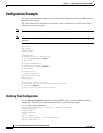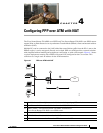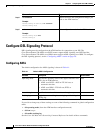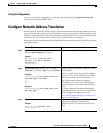
CHAPTER
4-1
Cisco Secure Router 520 Series Software Configuration Guide
OL-14210-01
4
Configuring PPP over ATM with NAT
The Cisco Secure Router 520 ADSL-over-POTS and Cisco Secure Router 520 ADSL-over-ISDN routers
support Point-to-Point Protocol over Asynchronous Transfer Mode (PPPoA) clients and network address
translation (NAT).
Multiple PCs can be connected to the LAN behind the router. Before traffic from the PCs is sent to the
PPPoA session, it can be encrypted, filtered, and so forth. PPP over ATM provides a network solution
with simplified address handling and straight user verification, as with a dial network.
Figure 4-1 shows
a typical deployment scenario with a PPPoA client and NAT configured on the Cisco router. This
scenario uses a single static IP address for the ATM connection.
Figure 4-1 PPP over ATM with NAT
1 Small business with multiple networked devices—desktops, laptop PCs, switches
2 Fast Ethernet LAN interface (inside interface for NAT, 192.168.1.1/24)
3 PPPoA Client—Cisco Secure Router 520 ADSL-over-POTS or
Cisco
Secure Router 520 ADSL-over-ISDN router
4 Point at which NAT occurs
5 ATM WAN interface (outside interface for NAT)
6 PPPoA session between the client and a PPPoA server at the ISP
92340
2
3
5
1
6
4
ISP


















